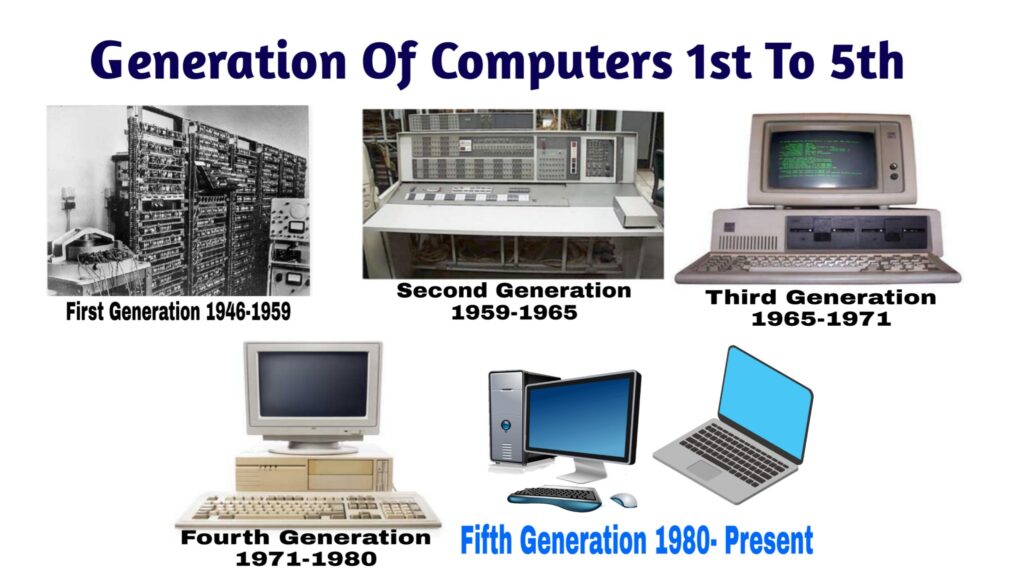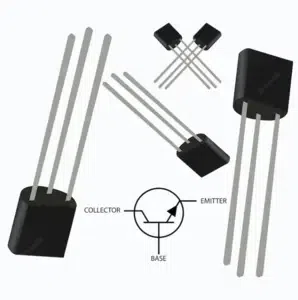Certainly, I’d be happy to explain the generations of computers to you. Computers have evolved over time through different generations, each marked by significant advancements in technology.
These generations of computers have brought about remarkable progress, with each new generation building upon the advancements of the previous ones. The evolution continues as technology continues to advance, shaping the way we live, work, and interact with the world around us.
Table of Contents

Summary For Generations Of Computers
| Generations of Computer | Time-Period | Evolving Hardware |
|---|---|---|
| First Generation | 1942s – 1955s | Vacuum Tube Based |
| Second Generation | 1955s – 1964s | Transistor Based |
| Third Generation | 1964s – 1975s | Integrated Circuit Based |
| Fourth Generation | 1975s – 1989 | Microprocessor Based |
| Fifth Generation | 1989 -Present | Artificial Intelligence Based |
First Generation Computers
The technology behind the primary generation computers was a fragile glass device, which was called a vacuum tube. These computers were very heavy and really large. These weren’t very reliable and programming on them was a tedious task as they used low-level programming language and used no OS. First-generation computers were used for calculation, storage, and control purpose. They were too bulky and large that they needed a full room and consume a lot of electricity.


Characteristics of First-Generation Computers
| Characteristics | Components |
|---|---|
| Main electronic component | Vacuum tube. |
| Programming language | Machine language. |
| Main memory | Magnetic drums. |
| Speed and size | Very slow and very large (often taking up an entire room). |
| Examples of the first generation | ENIAC, UNIVAC, etc. |
Second Generations Of Computers
Second-generation computers used the technology of transistors rather than bulky vacuum tubes. Another feature was the core storage. A transistor may be a device composed of semiconductor material that amplifies a sign or opens or closes a circuit.
Transistors were invented in Bell Labs. The use of transistors made it possible to perform powerfully and with due speed. It reduced the dimensions and price and thankfully the warmth too, which was generated by vacuum tubes. Central Processing Unit (CPU), memory, programming language, and input, and output units also came into the force within the second generation.


Characteristics of Second- Generations Of Computers
| Characteristics | Components |
|---|---|
| Main electronic component | Transistor. |
| Programming language | Machine language and assembly language. |
| Memory | Magnetic tape |
| Input/output devices | Magnetic tape and punched cards. |
| Power and size | Smaller in size, had low power consumption, and generated less heat (in comparison with the first-generation computers). |
Third Generation Computers
During the third generation, technology envisaged a shift from huge transistors to integrated circuits, also referred to as IC. Here a variety of transistors were placed on silicon chips, called semiconductors. The most feature of this era’s computer was speed and reliability. IC was made from silicon and also called silicon chips.
A single IC has many transistors, registers, and capacitors built on one thin slice of silicon. The value size was reduced and memory space and dealing efficiency were increased during this generation. Programming was now wiped out Higher level languages like BASIC (Beginners All-purpose Symbolic Instruction Code). Minicomputers find their shape during this era.


Characteristics of Third-Generation Computers
| Characteristics | Components |
|---|---|
| Main electronic component | Integrated circuits (ICs). |
| Programming language | High-level language. |
| Memory | Large magnetic disk. |
| Input/output devices | Magnetic tape, monitor, keyboard, printer, etc. |
Fourth Generation Computers
In 1971 First microprocessors were used, the large-scale of integration LSI circuits built on one chip called microprocessors. The advantage of this technology is that one microprocessor can contain all the circuits required to perform arithmetic, logic, and control functions on one chip.
The computers using microchips were called microcomputers. This generation provided even smaller size of computers, with larger capacities. That’s not enough, then Very Large Scale Integrated (VLSI) circuits replaced LSI circuits. The Intel 4004 chip, developed in 1971, located all the components of the pc from the central processing unit and memory to input/ output controls on one chip and allowed the dimensions to reduce drastically.
Technologies like multiprocessing, multiprogramming, time-sharing, operating speed, and virtual memory made it a more user-friendly and customary device. The concept of private computers and computer networks came into being within the fourth generation.


Characteristics of Fourth- Generations of Computers
| Characteristics | Components |
|---|---|
| Main electronic component | Very-large-scale integration (VLSI) and the microprocessor (VLSI has thousands of transistors on a single microchip). |
| Memory | semiconductor memory (such as RAM, ROM, etc.). |
| Input/output devices | pointing devices, optical scanning, keyboard, monitor, printer, etc. |
| Examples of the fourth generation | Apple Macintosh, Alter 8800, etc. |
Fifth-Generations of Computers
The technology behind the fifth generation of computers is AI. It allows computers to behave like humans. It is often seen in programs like voice recognition, area of medicine, and entertainment. Within the field of game playing also it’s shown remarkable performance where computers are capable of beating human competitors.
The speed is the highest, size is the smallest and area of use has remarkably increased within the fifth generation computers. Though not a hundred percent AI has been achieved to date but keeping in sight the present developments, it is often said that this dream also will become a reality very soon.


Characteristics of Fifth-Generation Computers
| Characteristics | Components |
|---|---|
| Main electronic component | Based on artificial intelligence, uses the Ultra Large-Scale Integration (ULSI) technology and parallel processing method (ULSI has millions of transistors on a single microchip and the Parallel processing method use two or more microprocessors to run tasks simultaneously). |
| Language | Understand natural language (human language). |
| Size | Portable and small in size. |
| Input/output device | Trackpad (or touchpad), touchscreen, pen, speech input (recognise voice/speech), light scanner, printer, keyboard, monitor, mouse, etc. |
| Example of the fifth generation | Desktops, laptops, tablets, smartphones, etc. |
People also read:- Happy Raksha Bandhan 2023- Pooja Vithi, Muhurat & Date


Pingback: Classification Of Computers 2023 » Dailyevents24.com
Pingback: 10 Scientific Ways To Learn Faster: Increase Your Memory – dailyevents24.com
Pingback: What Are The Applications Of Computer? 2024